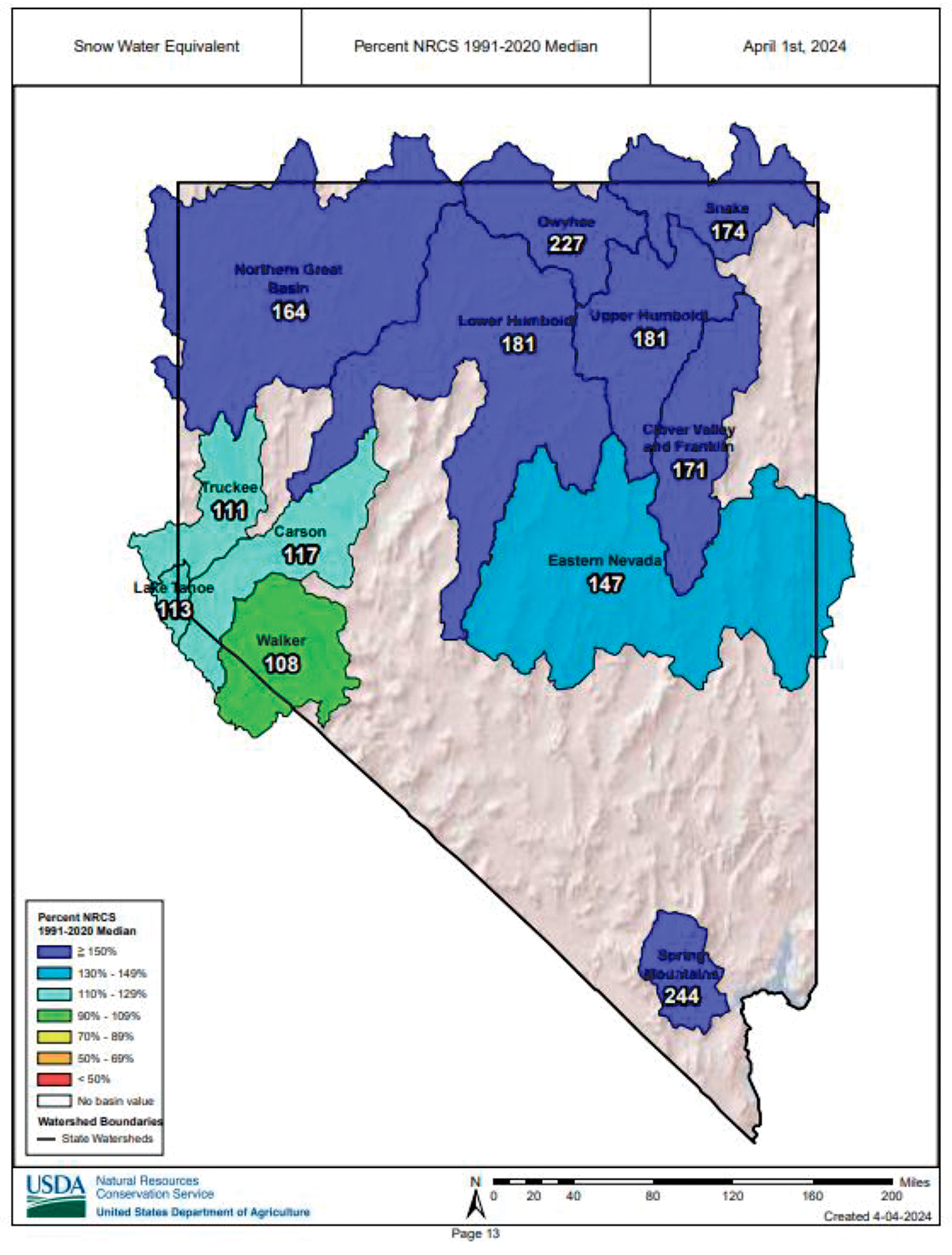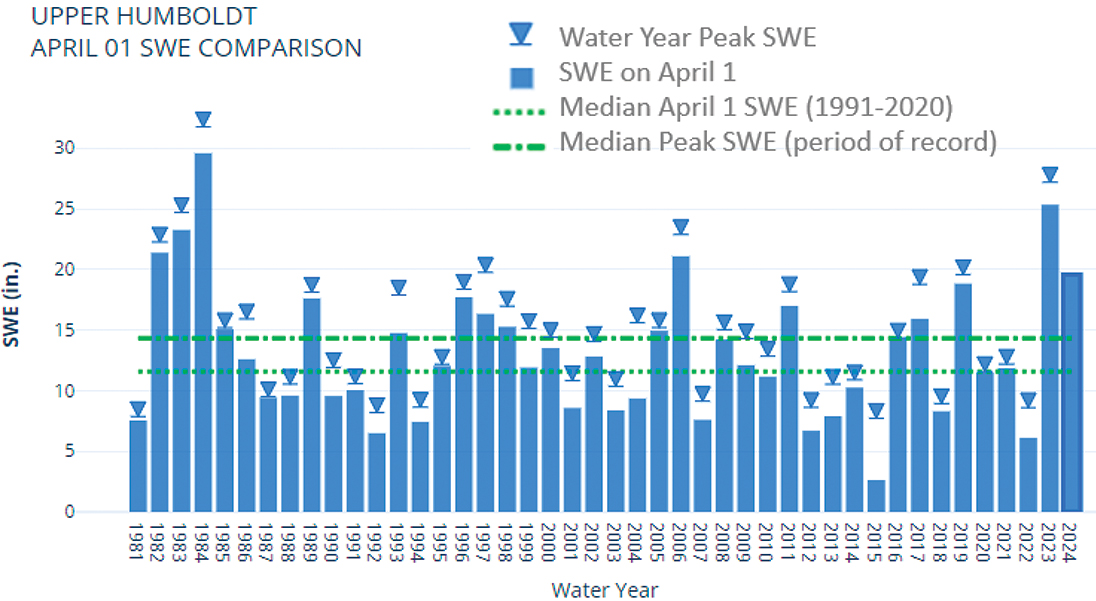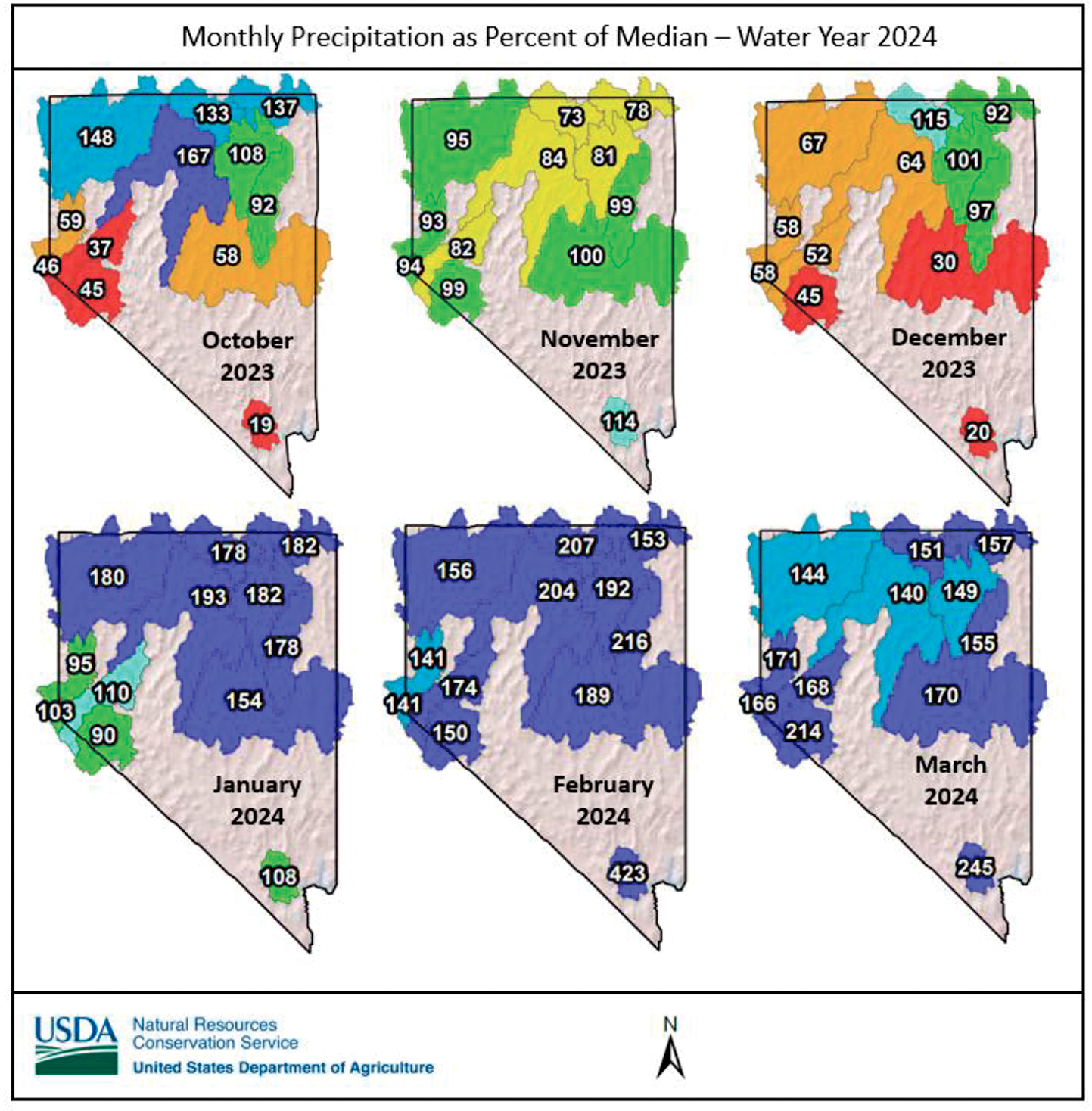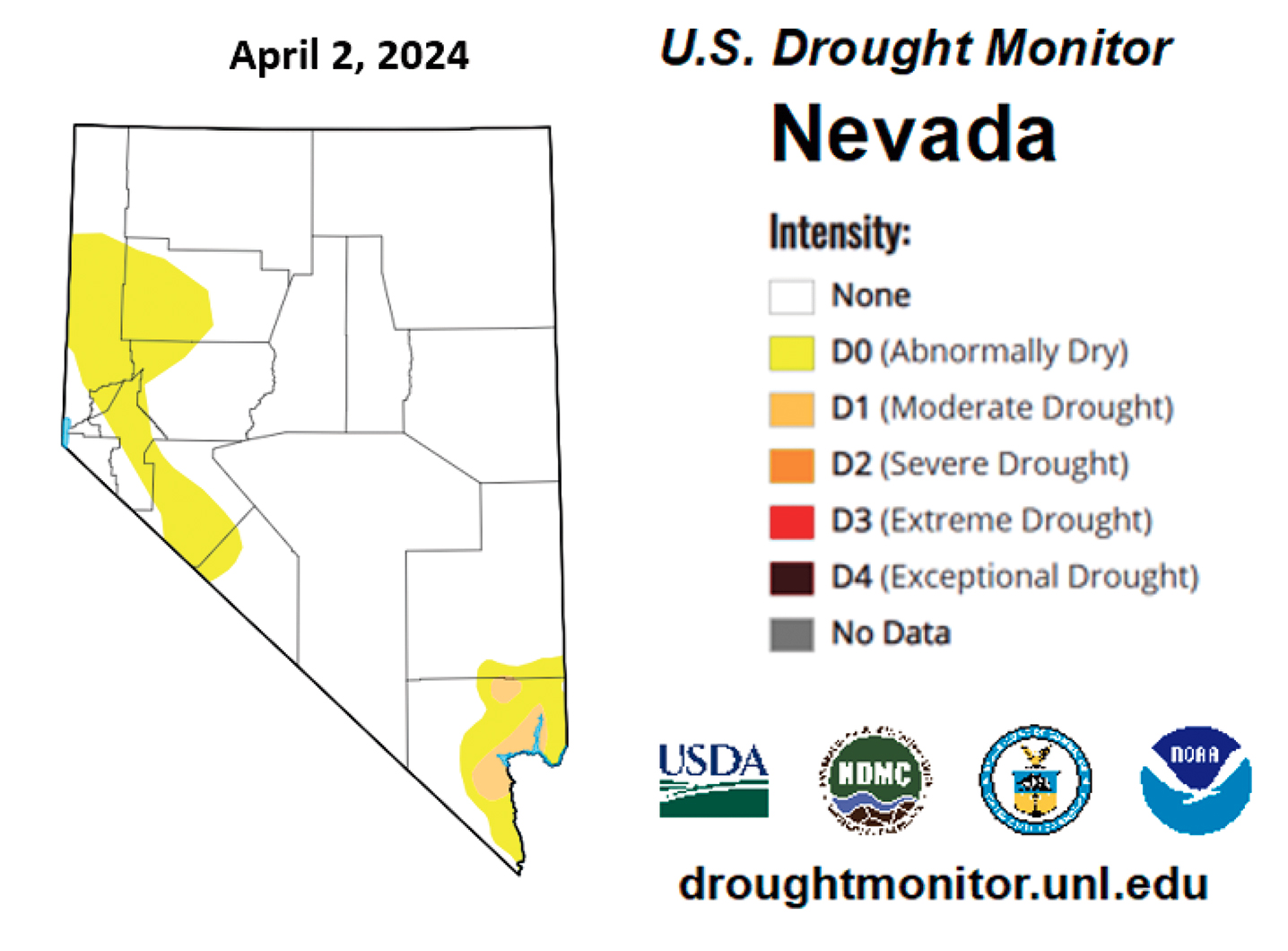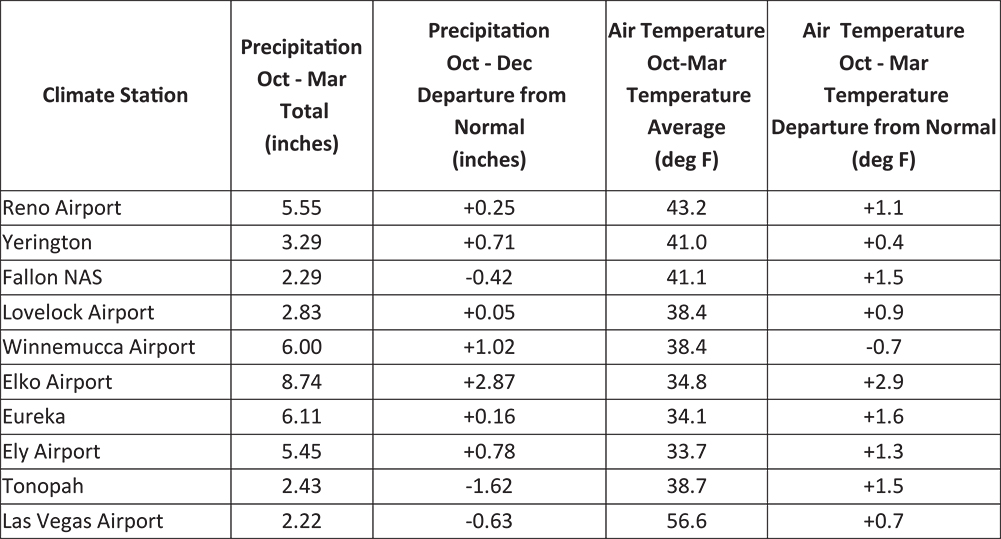 March snowstorms provided a good ending to winter after a disappointing start in December. Snowpacks for this winter are above normal across Nevada, which follows one of the biggest snowpacks ever measured across the Sierra Nevada, the Great Basin and the Colorado Basin in the winter of 2023. The last time Nevada had back-to-back winters with above normal snowpacks was in 2016 and 2017.
March snowstorms provided a good ending to winter after a disappointing start in December. Snowpacks for this winter are above normal across Nevada, which follows one of the biggest snowpacks ever measured across the Sierra Nevada, the Great Basin and the Colorado Basin in the winter of 2023. The last time Nevada had back-to-back winters with above normal snowpacks was in 2016 and 2017.
History
Nevada has the longest history of snow water measurements in the country. James E. Church, who worked at the University of Nevada, Reno, is considered the father of snow surveying. Church developed the snow tube design that snow surveyors still use today. These tubes core and weigh the snow water content of the snowpack.
The first measurement at Mount Rose was made in 1910 and April 1 measurements continue each year at this location. So, the Mount Rose snow course has the longest snow water measurement record in the United States and, most likely, worldwide.
Each winter, staff from USDA’s NRCS take readings and maintain equipment at 92 SNOTEL sites across Nevada and the eastern Sierra. Snowpack, precipitation, air temperature and soil moisture are monitored at the stations. NRCS Snow surveyors and cooperators from other state and Federal agencies also collect snow tube measurements at an additional 45 snow courses.
The data are used by hydrologists at the NRCS National Water and Climate Center to produce seasonal streamflow forecasts for the region’s water managers and water users. Water Supply Outlook Reports are also used by state and Federal agencies, Tribes, individuals, and organizations to make decisions regarding irrigation allocations and agricultural production, fish and wildlife management, municipal and industrial water supply, flood control, power generation and recreation.
Forecast percentages in NRCS Water Supply Outlook Reports have been based on medians, not averages, since 2022. The median is the middle value of the 1991-2020 dataset. The median is considered more representative of “normal” than the average since the median doesn’t get skewed upward by a handful of large years. The Normals Dashboard has a 15-minute YouTube presentation that goes into detail about how this impacts Nevada and can be watched at https://www.wcc.nrcs.usda.gov/ftpref/support/states/NV/web/normals.html.
NRCS publishes reports from January through May. The reports summarize snowpack, precipitation and water supply conditions throughout the state. Visit https://www.nrcs.usda.gov/nevada/snow-survey to see the latest report and subscribe for updates.
The snowpack started slow in the Truckee, Tahoe, Carson and Walker basins. The January 1 snowpack was only 44% of the median, ranking sixth lowest for the date back to 1981. There was only a 30% chance the Eastern Sierra snowpack would reach the median peak by April 1. That unlikely scenario happened with the help of March storms.
The Humboldt Basin has not seen back-to-back winters with this much snow since 1982 and 1983. The Upper Humboldt Basin’s April 1 snow water amount ranks seventh highest since 1981 compared to peak snow water amounts. After a relatively slow start to snow accumulation this winter, the Ruby Mountains change in snow water between January 1 and April 1 ranked second highest, just behind 2023.
Nearly all SNOTELs across northern Nevada measured January through March accumulation in the top five years, and eight SNOTELs had the highest or second highest January through March accumulation on record.
Precipitation
Water year precipitation in the mountains as measured by NRCS SNOTEL stations ranges from 99-103% of median in the Eastern Sierra basins, 107% in the Upper Colorado, 119% in the Spring Mountains, 121-141% across the rest of northern Nevada as on April 1. Monthly precipitation was very strong statewide from January through March with well above normal amounts each month.
Streamflow Forecasts
According to the NRCS April 1 streamflow forecasts, Nevada will likely have normal to well above normal April-July runoff. However, there are still a range of possible outcomes depending on the weather. Monitoring changing weather and hydrologic conditions in the coming months is important. Cool, wet or hot, dry weather conditions can create above- or below-normal precipitation and impact streamflow.
The Humboldt, Owyhee and Snake basins could be poised for one of the best snowmelt runoff seasons in several years. The April 1 50% exceedance forecasts in these basins range from 154-639% of the median (138-271% of average), and most rank above the 85th percentile compared to historic volumes. The mainstem of the Humboldt River is one to pay particular attention to. It generally has higher runoff volumes when back-to-back above normal snowpacks prime the system.
Valley and Rangeland Conditions
Seasonal snow cover replenishes soil moisture and provides water for plant growth on rangelands. A useful tool to track the lower elevation snowpack is NOAA’s Modeled Snow Water Equivalent Map, accessed at
https://www.nohrsc.noaa.gov/interactive/html/map.html. The April 1 map shows much of Nevada’s lower elevations received modest snow amounts the last weekend of March, which increased the total snow water across Nevada’s mountain ranges during March.
Drought Status
Most of Nevada is currently classified as drought-free. However, a portion of southern Nevada has moderate drought due to the multi-decade declines in storage in the lower Colorado reservoirs. The water level in Lake Mead has improved since July 2022, but storage is currently only 37% of capacity.
NRCS Offers Financial and Technical Assistance
Snow Survey is an important aspect of the work done by NRCS, but it is only one part of what the agency does. NRCS offers financial and technical assistance through several federally funded, voluntary conservation programs to help farmers and ranchers protect and conserve the natural resources we all depend on. Applications for programs are accepted year-round.
The Environmental Quality Incentives Program, commonly known as EQIP, is a voluntary, financial and technical assistance program providing funding to agricultural producers and non-industrial forest managers to address natural resource concerns and deliver environmental benefits such as improved water and air quality, conservation of ground and surface water, increased soil health and reduced soil erosion and sedimentation, improved or created wildlife habitat, and mitigation against drought and increasing weather volatility. EQIP funding can be used on private and public land.
The Conservation Stewardship Program (CSP) is for all private working lands and agricultural land under the jurisdiction of a tribe. This program provides annual payments for meeting certain benchmarks in the management of the land. Additional payments are earned by agreeing to complete enhancements to the land. On-farm benefits include increased crop yields, decreased inputs, wildlife habitat improvements, and better resilience to weather variables.
The Agricultural Management Assistance Program (AMA) helps producers use conservation to construct or improve watershed management structures or irrigation structures, install high tunnels, plant trees to form windbreaks or improve water quality. AMA funding can also mitigate financial risk through production or marketing diversification or the implementation of resource conservation practices including soil erosion control, integrated pest management or the transition to organic farming.
The Agricultural Conservation Easement Program (ACEP) helps landowners, tribes, and partners enroll wetlands, grasslands and farmlands into conservation easements. ACEP protects the agricultural viability and related conservation values of eligible land by limiting nonagricultural uses, protecting grazing use and related conservation values by restoring or conserving eligible grazing land, and protecting and restoring and enhancing wetlands on eligible land. Eligible partners include American Indian tribes, state and local governments and non-government organizations that have farmland, rangeland or grassland protection programs. Eligible landowners include private land owners, including land held by tribes and tribal members.
For more information and to find your nearest local office, visit:
https://www.nrcs.usda.gov/nevada.
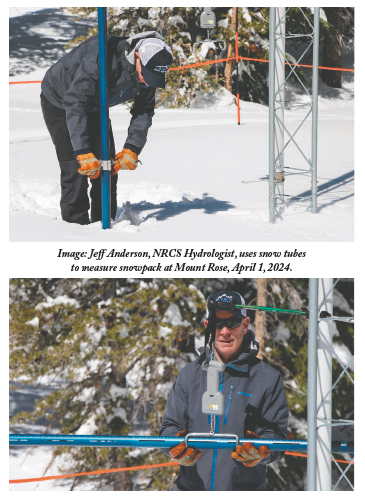 Snowpacks across the state have peaked above normal for the second year. April 1 snowpack percentages are:
Snowpacks across the state have peaked above normal for the second year. April 1 snowpack percentages are:
108-117% of median in the Eastern Sierra basins (Lake Tahoe, Truckee, Carson and Walker)
115% in the Upper Colorado basin
147% in Eastern Nevada
164-227% across other parts of northern Nevada including the Northern Great Basin, Humboldt, Owyhee and Snake basins
244% in the Spring Mountains in southern Nevada
April 1 Snowpack Map based on first of month SNOTEL readings and snow course measurements show above normal conditions across the state.
Upper Humboldt Basin comparison of April 1 snow water equivalent (blue bars) with each year’s peak snow water equivalent (triangles). Compared to 2023 and 2024, the last time back-to-back winters had similar snow amounts was in 1982 and 1983. Peak SWE typically occurs after April 1 in the Upper Humboldt Basin.
NRCS SNOTEL monthly precipitation as a percent of median across Nevada’s basins from October 2023 through March 2024.
Most of Nevada is currently classified as drought-free. However, a portion of southern Nevada has moderate drought due to the multi-decade declines in storage in the lower Colorado reservoirs. The water level in Lake Mead has improved since July 2022, but storage is currently only 37% of capacity. Drought status for April 2, 2024 Source: U.S. Drought Monitor
Valley Temperature and Precipitation: The table (below) provides a summary of water year precipitation and temperature from October through March for valley climate stations across the state. Most stations have been on average wetter and warmer than normal since October.
October 2023 through March 2024 summary of valley climate stations. Source: http://www.rcc-acis.org/
By: Natural Resources Conservation Service Staff

